Your Cart is Empty
Free Shipping for orders over $49 in Australia, $199 IN NEW ZEALAND/USA/CANADA AND $249 REST OF THE WORLD
Free Shipping for orders over $49 in Australia, $199 IN NEW ZEALAND/USA/CANADA AND $249 REST OF THE WORLD
Add description, images, menus and links to your mega menu
A column with no settings can be used as a spacer
Link to your collections, sales and even external links
Add up to five columns
Add description, images, menus and links to your mega menu
A column with no settings can be used as a spacer
Link to your collections, sales and even external links
Add up to five columns
Halloween - its History and Origins
by Linda Heaphy May 10, 2017
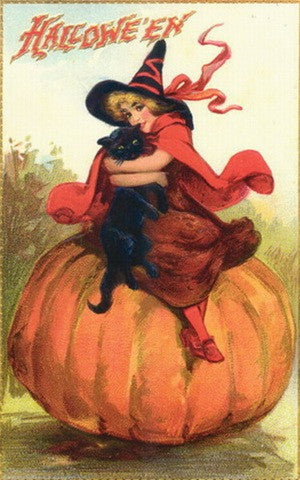
Vintage Halloween greeting card from the USA, circa 1940
Halloween is an annual festival observed on October 31, celebrating the eve of Hallowmas or All Saints Day on November 1. Largely appropriated by the Americans as a spooky celebration involving dressing up and the exchange of candy, Halloween has its roots in the Gaelic/Celtic festival of Samhain, an old Irish word that translates roughly to "summer's end”.
Samhain was a complex festival of great importance to the Gaelic peoples, who recognised the importance of balancing the intertwining forces of existence: darkness and light, night and day, cold and heat, death and life. The Celtic year was divided into only two seasons: the light and the dark. Samhain was particularly important because it celebrated not only the coming of the dark season but also the start of the Celtic New Year. The most magically potent time of Samhain was its eve, called Oidhche Shamhna, when huge feasts were prepared and great bonfires (in Gaelic the ‘tine cnámh’ or bone fire) lit by Druid priests. People and their livestock would walk between two bonfires as a cleansing ritual, and the bones of slaughtered livestock were cast into its flames. Personal prayers were also thrown into the fire and gifts offered up in thanksgiving for the harvest. It was also believed that the boundaries between the living world and the Otherworld were weakened at Samhain, allowing the dead to return to the places where they had lived. Villagers put out offerings of food and drink for their dead, set places at their tables and left their windows, doors and gates unlocked to give them free passage into their homes. Divination of the events of the coming year was another highlight of Samhain and hazelnuts were often used to foretell the future along with apple peels, which were thrown over the shoulder to reveal the initial of future spouses’ names.
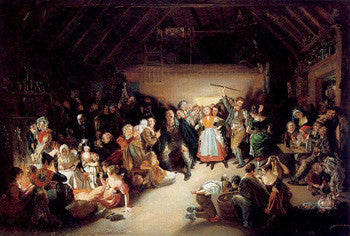
Snap-Apple Night, painted by Irish artist Daniel Maclise in 1833. It was inspired
by a Halloween party he attended in Blarney, Ireland, in 1832.
The caption in the first exhibit catalogue:
There Peggy was dancing with Dan
While Maureen the lead was melting,
To prove how their fortunes ran
With the Cards could Nancy dealt in;
There was Kate, and her sweet-heart Will,
In nuts their true-love burning,
And poor Norah, though smiling still
She'd missed the snap-apple turning.
While Maureen the lead was melting,
To prove how their fortunes ran
With the Cards could Nancy dealt in;
There was Kate, and her sweet-heart Will,
In nuts their true-love burning,
And poor Norah, though smiling still
She'd missed the snap-apple turning.
On the Festival of Hallow Eve.
Today, Halloween festivities include activities like trick-or-treating, attending costume parties, carving jack-o'-lanterns out of pumpkins, lighting bonfires, apple bobbing, visiting haunted attractions, playing pranks, telling scary stories and watching horror films. Some of these traditions date back to Celtic times: apple bobbing was a Samhain custom associated with the legend of Emhain Abhlach (‘Paradise of Apples’), also called Avalon, where anyone who found and ate of the fruit of a magical apple tree after traveling across the sea would enjoy a blissful afterlife. Carving guardian jack-o’-lanterns out of turnips and placing them at the door or gate was also a Samhain practice, warding off the malevolent or unfriendly spirits that accompanied the dead on their return to the living world – in turn a throwback to the more grizzly early Celtic tradition of ritually beheading human sacrifices and leaving them at the door as warnings. Young people would put on disguises or swap clothing (“guising”) and pretend to be the returning dead to trick their elders. The formalities and social niceties of society were weakened at Samhain along with the barriers separating the living and the dead, allowing for boisterous behaviour and the playing of tricks and mischievous pranks.
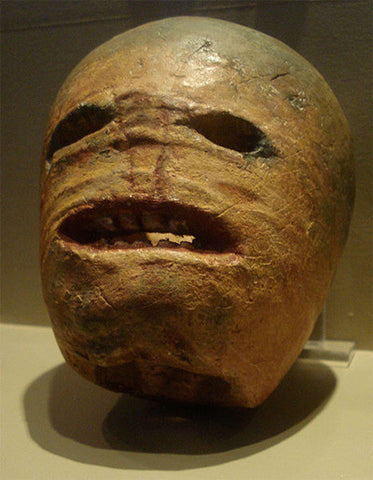
the stuff of nightmares. A traditional Irish turnip jack-o'-lantern from the early 20th century. Museum of Country Life, Ireland. Photo credit: Rannpháirtí anaithnid
With Christianisation, Samhain was integrated into the Catholic calendar of festivals from at least the 8th century to become Hallowmas, or All Saints' Day, when the dead who had been canonised that year were honoured. November 2nd became All Souls Day, when prayers were offered to the souls of newly departed and those waiting in Purgatory for entry into Heaven.
While the celebration of Halloween has waned in England and Ireland with the passing centuries, in America it has been reborn - in fact, if it weren’t for the Americans taking up the baton with such gusto, the secular festival might have died out altogether. Halloween arrived in America with the first of the Irish and Scottish Catholic colonists. It quickly grew in popularity, probably because it coincided so neatly with the end of the summer harvest. The jack-o’-lantern was changed from a turnip to a pumpkin, because of its plentifulness in American harvests, and divination was conducted with walnut shells rather than hazelnuts. Trick-or-treating and guising also remained popular customs. After the 1930’s, the commercialisation of American Halloween began in earnest, with the first mass-produced costumes appearing in stores around this time, along with specialised candies and party decorations. The American celebration of Halloween has had a huge impact on how the event is observed in other countries, and its influence has largely eclipsed the more traditional and beautiful pagan elements. Very popular in many parts of East Asia, in Australia and New Zealand the coincidence of Halloween with the season of spring has robbed the festival of its most important traditional meaning and is barely observed. However, there is still something in the celebration of Halloween for all of us: a time to give thanks for the year past, a time to remember departed loved ones, a celebration of the bond among all people and a sense of community and belonging.
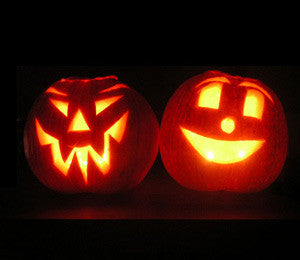
The less scary modern version of the jack-o'-lantern seen today in America. Or is it?
A candle is lit in the mouth of the lantern to guide the dead back to their homes on
Hallows Eve. Photo courtesy of Laszloen.

A sanitised image of Halloween complete with flying witch and haunted house.
Traditional Celtic Chant for Samhain
A year of beauty. A year of plenty. A year of planting. A year of harvest.
A year of forests. A year of healing. A year of vision. A year of passion.
A year of rebirth. A year of rebirth. This year may we renew the earth.
Let it begin with each step we take. Let it begin with each change we make.
Let it begin with each chain we break. And let it begin every time we awake.
References and Further Reading
Kelley, Ruth Edna.Hallowe'en in America.
Knight, Kevin. Halloween and All Saints Day.
Feast of Samhain/Celtic New Year/Celebration of All Celtic Saints November 1. All Saints Parish
HerodotusOctober 31, 2010. The Origins of Halloween Part 1: Samhain and the Celtic Time of Spirits
Samhaim. Wikipedia, retrieved 20th October 2011

Traditional Halloween greeting card, Scotland
Leave a comment
Comments will be approved before showing up.
Also in Holidays and Festivals
Articles
About the Author
- Linda has a Honours degree in Marine Biology and a PhD in Ecology from the University of NSW, Australia. She has travelled extensively and is a passionate writer on subjects as diverse as the role played by women throughout history, tribal communities and their customs, symbology and ethnology, talismans and their history. Occasionally she also writes about her travel experiences, her new life on a 25 acres in the Northern Rivers region of northern Australia and her black miniature poodle Phoenix. She is currently writing her first book on talismans.
About Us
-
The Kashgar Philosophy

Kashgar began through a love of travel.
In 1989 my father Bernard packed in his house painting business and set off for two years on a backpacking trek to the remotest corners of the world. When he finally arrived in the oasis city of Kashgar, China, he was so impressed with its history that he decided to start a new life collecting and selling exotic goods from all over the world. For 2000 years the legendary city of Kashgar was a melting pot of ideas and a key trading post on the historic Silk Road. It was this unique combination of philosophy and trade that my father wanted to recreate at home.
Starting in markets in 1991, he opened his first store in the Sydney suburb of Newtown in 1994. I gave up my own career as a government scientist to join him in 2000 and soon convinced my partner Ian to join us in what was to become the Family Business.
Today our version of Kashgar stocks a hugely diverse range of furniture, rugs, textiles, antiques, handicrafts and jewellery sourced from over twenty different countries including India, Nepal, Tibet, China, Thailand, Burma, Laos, the Philippines, Vietnam, Mexico, Peru, Turkey, Palestine, Syria, Afghanistan and Turkmenistan. Our collection includes contemporary and tribal silver and gold jewellery, a unique range of headhunting curios, antique Buddhist relics and a collection of one-off necklaces, earrings and bracelets that I design and create myself using the beads and jewellery making techniques of ethnic minorities from around the globe.
Kashgar is a philosophy as well as a store. We are committed to supporting traditional artisans and small village communities by selling authentic handcrafted goods which are personally collected by us. By supporting traditional methods of design and production we hope to encourage local cottage industries which have a low impact on the environment and help ethnic minorities maintain their self-sufficiency into the 21st Century. We are particularly committed to assisting women around the world and to this end have worked with several organisations including the Hua Bin Women's Union of Vietnam, the East Timorese Women's Association and Tikondane in Zambia. Time honoured means of craftsmanship and traditional ways of life are disappearing as people all over the world give up their identity in favour of jeans and T-shirts. We see our trade as a means of staving off the inevitable encroachment of the 21st century, assisting communities to decide for themselves which parts of the western world they wish to incorporate (medicine, education) and which they wish to reject (prostitution, drug production, begging and servitude to warlords). We encourage our customers to think of the handicrafts and artifacts they buy from us as an investment: a piece of history and a way of life that may soon be gone forever.
Kashgar has recently closed its retail outlet and gone completely online.
In the past our pieces appeared in many movies including The Hobbit, Mission Impossible 2, Queen of the Damned, Scooby Doo, Moulin Rouge and Wolverine, and in many televisions series, as well as in plays, commercials and exhibitions. We've found special pieces for individual customers as well as for film sets, event management companies, hotels, businesses, consulates and embassies. The uniqueness of our stock means that we are also very appealing to interior and fashion designers with a taste for the exotic.
There is something for everyone at Kashgar - collectors, the curious, those looking for a special present or for something unique to adorn the home. Most of our items are one-off specialties; other pieces we only stock in small quantities so as to continuously offer a wide and ever-changing range of interesting products. We are also packed with ideas for decorating home and work premises that will challenge your established concepts of design and storage.
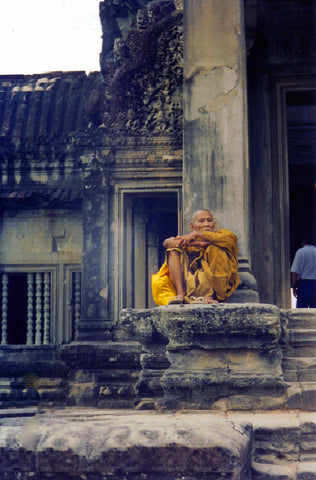
Please enjoy - Linda Heaphy
Become a Kashgar nomad and join our mailing list...
Sign up to get the latest on sales, new releases and more …




